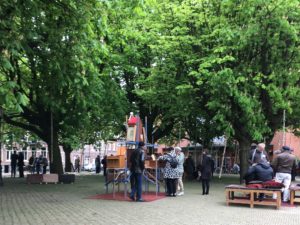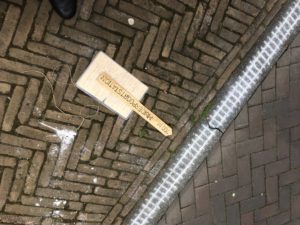In one small area in east Amsterdam, less than 20 square blocks, more than 2800 Jewish people were rounded up and murdered. For the last five years, their present-day neighbors and others have gathered all day long for a ritual to remember them. The central square, the Kastanjeplein, is full of tall chestnut trees with towering blossoms, each in the form of a tree. From each flutter long strips of crushed paper representing the untold stories of the dead.

Volunteers guide people through the ritual’s steps, beginning with the gift of time which encompasses present, past and future, and divesting of everyday time. One’s intention is assessed and written down: I chose “paying attention,” rather than remembering or restoring or other options. Next, from a pile of wooden drawers full of notebooks and photographs, I found a specific Jewish individual to memorialize: Josua Samuel de Vries, who lived in the Beukenweg 22. (Later, I looked him up in the Digital Monument to the Jews of the Netherlands and discovered that the family owned a cigar shop there, according to the police records from 1940.)
Even in late afternoon, dozens of people were participating. They were of every age – the youngest perhaps 5 years old, the oldest in her eighties – and of every race. A woman in a bright pink hijab stood out. An Afro-Caribbean man pushing a stroller stopped to ask what was going on, and soon he too was drawn into the process.
I was directed to pick up a wooden slat to make a marker for Mr. de Vries, and chose fabric to cover it from a trunk. Having done this before in 2015 (you can read my more complete account here), I selected a striped fabric so I could follow the lines to make a more regular design After it was stapled on by a helper, I used stencils to mark out his name, seated at a picnic table. 
Soon we were chatting with the woman sitting opposite, who wanted to know why two Americans were doing this, and before long the story of An Address in Amsterdam came tumbling out. Everyone around us was working diligently, some with real artistic talent, others more utilitarian in their approach as I was. Because I knew nothing about Mr. de Vries then, I simply added a flower beside his name.


When we had made our markers, we followed the railroad track which was chalked on the curb surrounding the square. Significant places were marked along the way, showing the number of kilometers distant from the spot where we were standing. Reaching Muiderpoort Station only 700 meters away was chilling, not to mention Auschwitz. Along the way were laminated copies of letters Jewish people threw from the deportation trains. “Don’t worry.” “Send lower underwear.” “The wholefamily is here together.” At the end, I spent a few moments meditating about Mr. de Vries.
With the help of a volunteer, I found his address on the map of the neighborhood which was laid out in the center of the square. His whole family was already there.

While laying the marker in place, you choose your own words to say something like “I am bringing you home to be with your family.” You ring a bell which you’ve chosen either by color or by note. Around you are the sounds of the other bells, the sight of others bending over, standing back and looking at the appalling patchwork of the dead. They have the dignity of being marked and remembered, but the fact that they were all from these few streets and all were deliberately slaughtered is inescapable. The long chains of crushed paper, their stories, swayed in the cold wind.
Each year’s markers are added to the prior years. Even though this ritual has been done for five years, less than half the people who died have markers.
We were offered a hot cup of tea in porcelain cups, and documented our experience. An old fashioned accordion file held more photos and documents to read. Every detail, even that file folder, was from the time when these people were all alive, when the cigar store was thriving, when the streets were crowded with them and all their kin.
We were brought back to ordinary time by returning the cards which we’d received at the beginning, handing them through an empty clock face. But the hand which took them gave something, too: a card for “time for poetry,” and another with “time for beauty.”
This is what was taken from them forever. In their memory, we mustn’t waste it.

Remembrance Day is May 4 every year in the Netherlands. Words will never be enough to honor the suffering of those who died in the war – particularly the Jewish and other people who were rounded up and murdered. This year, I followed four different pathways which go beyond words on a single day, and I’ll write about each of them.

